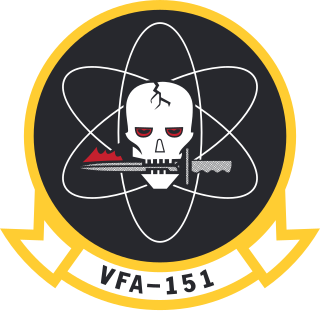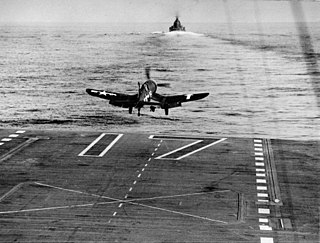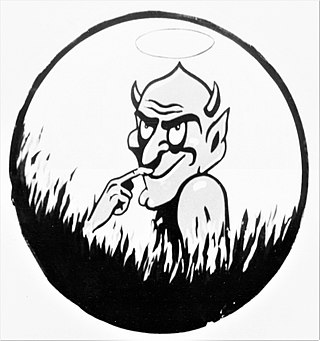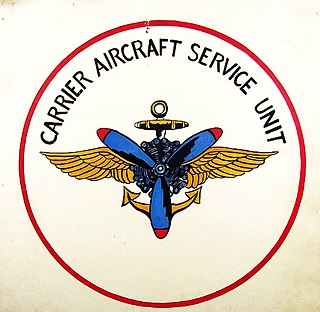
The Vought F4U Corsair is an American fighter aircraft that saw service primarily in World War II and the Korean War. Designed and initially manufactured by Chance Vought, the Corsair was soon in great demand; additional production contracts were given to Goodyear, whose Corsairs were designated FG, and Brewster, designated F3A.

USS Franklin, nicknamed "Big Ben," was one of 24 Essex-class aircraft carriers built during World War II for the United States Navy, and the fifth US Navy ship to bear the name. Commissioned in January 1944, she served in several campaigns in the Pacific War, earning four battle stars. In March 1945, while launching strikes against the Japanese mainland, she was badly damaged when a single Japanese dive bomber struck her with two bombs. The attack resulted in the loss of 807 of her crew and Franklin became the most heavily-damaged United States aircraft carrier to survive the war. The complement of Franklin suffered 924 killed in action during the war, the worst for any surviving U.S. warship and second only to that of USS Arizona.

USS Bataan (CVL-29/AVT-4), originally planned as USS Buffalo (CL-99) and also classified as CV-29, was an 11,000 ton Independence-class light aircraft carrier which was commissioned in the United States Navy during World War II on 17 November 1943. Serving in the Pacific Theatre for the entire war, taking part in operations around New Guinea, the Invasion of the Mariana Islands, the Battle of the Philippine Sea, the Battle of Okinawa, and Attacks on the Japanese home islands. After World War II's end she was converted into an anti-submarine carrier and placed in reserve on 11 February 1947.

USS Sitkoh Bay (CVE-86) was the thirty-second of fifty Casablanca-class escort carriers built for the United States Navy during World War II. She was named after Sitkoh Bay, located within Chichagof Island, of the Territory of Alaska. The ship was launched in February 1944, commissioned in March, and served as a replenishment and transport carrier throughout the Philippines campaign, the Invasion of Iwo Jima and the Battle of Okinawa. She was decommissioned in November 1946, when she was mothballed in the Atlantic Reserve Fleet. With the outbreak of the Korean War, however, she was called back to service, continuing to serve as a transport and utility carrier with the Military Sealift Command until 1954, when she was once again decommissioned, and mothballed in the Pacific Reserve Fleet. Ultimately, she was broken up in January 1961.

Strike Fighter Squadron One Five One (VFA-151) nicknamed the Vigilantes are a United States Navy F/A-18E Super Hornet fighter squadron stationed at Naval Air Station Lemoore, California. The squadron is a part of Carrier Air Wing 9 (CVW-9). As part of CVW-9, the squadron's tail code is NG and its radio callsign is "Ugly".
Fighter Squadron 11 or VF-11 was an aviation unit of the United States Navy. It was originally established as VF-5 on 1 February 1927, redesignated as VF-5S on 1 July 1927, redesignated as VF-5B in January 1928, redesignated VB-1B on 1 July 1928, redesignated VF-5B on 1 July 1930, redesignated VF-5S in July 1932, redesignated VF-5B in April 1933, redesignated VF-4 on 1 July 1937, redesignated VF-41 on 15 March 1941, redesignated VF-4 on 4 August 1943, redesignated VF-1A on 15 November 1946, redesignated VF-11 on 2 August 1948 and disestablished on 15 February 1959. It was the second US Navy squadron to be designated VF-11.

Fighting Squadron 10 (VF-10), also known as the "Grim Reapers", was an aviation unit of the United States Navy, established on 3 June 1942 and disestablished on 26 November 1945.

Marine Fighting Squadron 511 (VMF-511) was a fighter squadron of the Marine Corps and Marine Forces Reserve during World War II and the Cold War which flew aircraft types such as the F6F Hellcat, F4U Corsair, and the F-8 Crusader. They were originally activated during World War II and fought during the Battle of Okinawa and the Battle of Balikpapan (1945). They specialized in close air support and during the course of the war were credited with only one plane shot down.

Fighter Squadron 12 or VF-12 was an aviation unit of the United States Navy. Originally established on 9 January 1943, it was disestablished on 17 September 1945. It was the first US Navy squadron to be designated as VF-12.

VA-106 was an Attack Squadron of the U.S. Navy. Originally established as Bomber-Fighter Squadron Seventeen (VBF-17) on 2 January 1945, it was redesignated Fighter Squadron Six B (VF-6B) on 15 November 1946, redesignated VF-62 on 28 July 1948, redesignated Attack Squadron 106 (VA-106) on 1 July 1955, it was disestablished on 7 November 1969. It was the second US Navy squadron to be designated VA-106.

VA-34, nicknamed the Blue Blasters, was an Attack Squadron of the U.S. Navy. The squadron was established as Fighter Squadron VF-20 on 15 October 1943, redesignated as VF-9A on 15 November 1946, as VF-91 on 12 August 1948, and as VF-34 on 15 February 1950. It was finally redesignated VA-34 on 1 July 1955. The squadron was disestablished on 1 June 1969. It was the second squadron to bear the VA-34 designation, the first one having been renamed VA-35 in 1950.
Fighter Squadron 13 or VF-13 was an aviation unit of the United States Navy. Established on 2 November 1943, it was disestablished on 20 October 1945. It was the first US Navy squadron to be designated as VF-13.
Fighter Squadron 1 (VF-1) was a fighter squadron of the United States Navy. Originally established as Fighter Squadron 4 (VF-4) on 1 May 1943, it was redesignated VF-1 on 15 July 1943 and disestablished on 25 October 1945. It was the third US Navy squadron to be designated VF-1.
Fighter Squadron 15 or VF-15 was an aviation unit of the United States Navy. Originally established on 1 September 1943, it was disestablished on 20 October 1945. During six months of combat in 1944 the squadron destroyed more enemy planes than any other squadron in the Pacific War. Twenty-six of the squadron's pilots became aces.
Fighting Squadron 9 or VF-9 was an aviation unit of the U.S. Navy, originally established on 1 March 1942, it was disestablished on 28 September 1945.

Fighter Squadron 84 or VF-84 was an aviation unit of the United States Navy. Originally established on 1 May 1944, it was disestablished on 8 October 1945. It was the first US Navy squadron to be designated as VF-84.

The attack on Kure was an air raid conducted during the Pacific War by the United States Navy on 19 March 1945. It targeted the remnants of the Japanese Combined Fleet located in and near the Japanese city of Kure. The attack by 321 aircraft was unsuccessful, as no Japanese warships were sunk though several were damaged. Japanese forces struck the American fleet on the morning of 19 March, and crippled one aircraft carrier and badly damaged another.

For the April 1945 invasion of Okinawa, the Allies assembled the most powerful naval force in history. Since the few remaining capital ships of the Imperial Japanese Combined Fleet had been sunk or otherwise put out of action at the Battle of Leyte Gulf, the Allies were effectively unopposed in terms of major surface vessels; a single mission consisting of the superbattleship Yamato and a few escorts was undertaken, but the task force did not get within 200 nautical miles of the invasion area. The main Japanese naval opposition within the invasion area came from hundreds of Imperial Japanese Navy Shin'yō-class suicide motorboats and Maru-Ni Imperial Japanese Army attack boats.

Fighting Squadron 18 (VF-18) was an aviation unit of the United States Navy which served aboard USS Intrepid (CV-11) in the fall of 1944. It was the second squadron to bear the designation VF-18.

Carrier Aircraft Service Units (CASU) were United States Navy units formed during World War II for the Pacific War to support naval aircraft operations. From 1942 to 1946, 69 Carrier Aircraft Service Units were formed to repair and maintain aircraft. The first unit was deployed to Naval Station Pearl Harbor. The CASU-11, was deployed on January 22, 1943 at Naval Air Station San Diego. During the war the Navy lacked enough aircraft carriers to complete all the operational requirements.
























